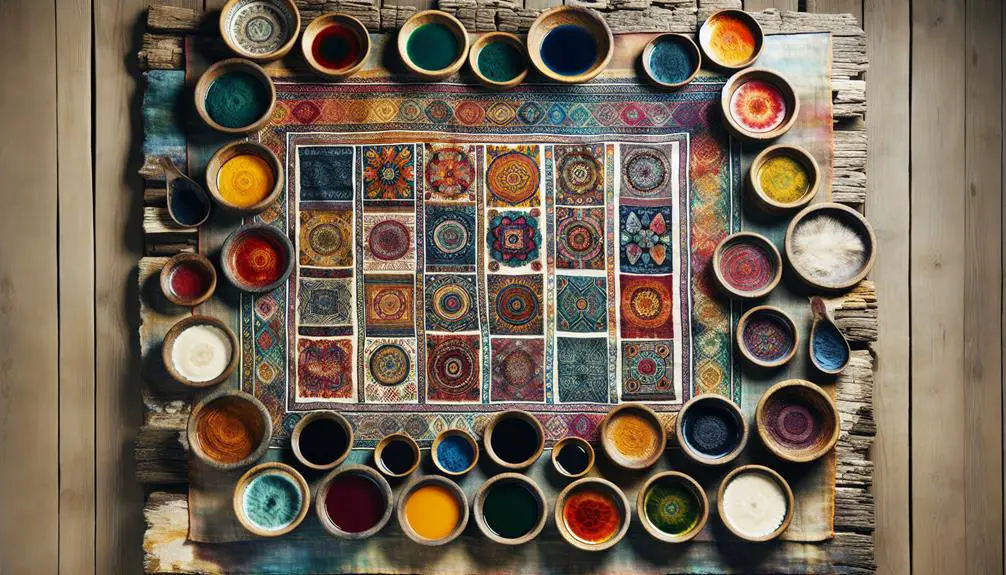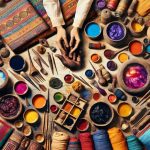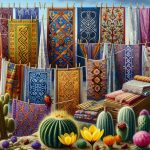Imagine a tapestry woven with threads of human ingenuity and creativity, where each strand represents a different era of fabric dyeing. You can trace these vibrant lines back to ancient Egypt, where natural dyes were first harnessed, moving through the indigo waves that colored medieval Europe, and arriving at the groundbreaking introduction of synthetic dyes in the 19th century. Today, the industry faces new challenges and trends, including a resurgence of traditional methods and a growing focus on eco-friendly practices. Are you ready to explore how these shifts have shaped the colorful world of fabric dyeing?
Table of Contents
Key Takeaways
- Early fabric dyeing utilized natural sources like plants, roots, and insects for vibrant colors.
- Indigo has played a significant role in fabric dyeing, with traditional methods still influencing modern practices.
- The mid-19th century saw the advent of synthetic dyes, allowing for mass production and vivid color saturation.
- The 20th century introduced advanced machinery and techniques for precise and efficient color application.
- Contemporary dyeing trends emphasize sustainability, using eco-friendly dyes and water-efficient methods.
Early Natural Dyes
How did ancient civilizations bring color to their textiles?
They mastered the use of plant-based dyes, a technique that transformed plain fabrics into vibrant works of art.
You'd be amazed by the ingenuity they displayed in extracting colors from nature.
By using plants, roots, bark, and even certain insects, they created a remarkable palette of hues.
To start the dyeing process, you'd first need to gather the raw materials.
For example, indigo plants were used for blue, madder roots for red, and walnut shells for brown.
Once collected, these materials were often boiled to extract the dye.
It's a straightforward but labor-intensive process.
The fabric was then soaked in the dye bath, often involving repeated dipping and drying to achieve the desired intensity.
You'll find that the ancients didn't rely on synthetic chemicals; instead, they utilized mordants—natural substances like alum or iron—to help the dye bond with the fabric fibers.
This not only enhanced the color but also secured its longevity.
The practice of using plant-based dyes wasn't just about aesthetics; it reflected a deep understanding of natural resources and an impressive level of craftsmanship.
Ancient Egyptian Dyeing
In ancient Egypt, they used plants, insects, and minerals as natural dye sources. Their dyeing methods were quite advanced, involving mordants to fix the colors to fabrics.
This practice wasn't just practical; it held deep cultural significance, symbolizing status and spirituality.
Natural Dye Sources
Ancient Egyptians relied on a variety of natural sources like plants, insects, and minerals to create vibrant dyes for their fabrics. By harnessing plant pigments, they not only achieved rich colors but also engaged in sustainable practices that modern dyeing techniques often overlook. The use of natural dyes minimized environmental impact and showcased a deep understanding of their surroundings.
To understand the brilliance of these ancient hues, let's break down some of the primary sources they used:
| Natural Source | Color Produced | Common Use |
|---|---|---|
| Madder Root | Red | Linen |
| Indigo | Blue | Wool |
| Saffron | Yellow | Silk |
| Ochre | Brown | Cotton |
You'll notice that each source provided a distinct and vibrant color, demonstrating the Egyptians' mastery in fabric dyeing. Madder root was prized for its deep red, while indigo leaves created a striking blue. Saffron, though rare, yielded a brilliant yellow, and ochre produced various shades of brown.
These natural dyes allowed the Egyptians to create a vivid palette, expressing their culture and status through their clothing. By choosing sustainable methods and natural sources, they crafted a legacy that continues to inspire modern dyeing techniques.
Dyeing Methods Used
The Egyptians employed several ingenious dyeing methods that allowed them to produce lasting and vibrant colors on their fabrics. You'd be amazed at how their techniques laid the groundwork for modern practices.
One of their primary methods was using natural mordants to fix the dyes, ensuring longevity and vibrancy.
Imagine witnessing the creation of these ancient masterpieces:
- Intricate tie-dye patterns: Far from the casual tie-dye revival of recent years, Egyptian tie-dye involved precise folding and binding to create complex designs.
- Wax-resist dyeing: Similar to batik techniques, Egyptians applied beeswax to fabric to resist dyes and create stunning, intricate patterns.
- Natural dye vats: Large containers filled with natural dyes from plants, minerals, and insects, where fabrics were submerged to absorb rich hues.
- Hand painting and stamping: Using brushes and carved stamps, Egyptians could apply dyes in specific, detailed designs, achieving a level of artistry that's truly impressive.
When you explore these methods, you'll notice how they reflect a deep understanding of chemistry and artistry. Mastering these ancient techniques can enrich your knowledge and appreciation of fabric dyeing, connecting you to a tradition that spans millennia.
Cultural Significance
You can't overlook how fabric dyeing was deeply woven into the social and spiritual fabric of ancient Egyptian life. The Egyptians didn't just see color as an aesthetic choice; they imbued it with layers of traditions and symbolism. Each hue held specific meanings that were essential in daily life, rituals, and celebrations.
For instance, the color red symbolized life and victory, often used in ceremonies to invoke protection and strength. Blue, derived from the precious lapis lazuli, represented the heavens and water, symbolizing fertility and rebirth. White, associated with purity and sacredness, was prevalent in religious rituals and temple ceremonies. You'd find that the meticulous selection of colors wasn't random but a deliberate reflection of their cultural values.
In grand celebrations, such as the Opet Festival, dyed fabrics played a pivotal role. Priests and participants donned vividly colored garments to honor the gods and mark the occasion's significance. Dyeing techniques weren't just functional but were integral to maintaining the social order and spiritual balance.
Indigo and Its Influence
You'll find indigo's rich history fascinating, from ancient dyeing methods to its cultural significance across the globe. This vibrant blue dye has left an indelible mark on various societies and continues to influence modern fashion trends.
Let's explore how indigo has shaped both ancient and contemporary fabric dyeing practices.
Ancient Dyeing Methods
Indigo dyeing, originating from ancient civilizations, revolutionized fabric coloring with its rich, deep blue hues. You can trace the roots of this technique back to plant-based dyes derived from the indigofera plant. These traditional techniques were meticulously crafted, requiring an understanding of both botany and chemistry, long before modern science explained the processes. The artisans of ancient times mastered the art of extracting dye from indigo plants and developed methods to ensure vibrant and long-lasting colors.
Picture the process:
- Harvesting indigo leaves: Workers gathered lush green leaves in the early morning to preserve their potency.
- Fermentation: Leaves were soaked in water, initiating a fermentation process that extracted the dye.
- Reduction vats: The fermented leaves were mixed in vats with a reducing agent to produce a dye solution.
- Dipping and oxidizing: Fabrics were repeatedly dipped and exposed to air, transforming the material into a striking blue.
Mastering indigo dyeing was an intricate dance of timing, skill, and environmental awareness. It's no wonder that even today, the allure of indigo persists, inspiring modern artisans to explore these ancient methods. By understanding these techniques, you can appreciate the profound expertise of ancient dyers and the timeless beauty they created.
Cultural Significance Worldwide
Across the globe, indigo has woven itself into the cultural fabrics of countless societies, symbolizing everything from royalty to rebellion. You'll see its global impact in the rich, deep blues of Japanese kimonos and the vibrant hues of West African boubous. Each region's unique traditional techniques have preserved indigo's significance through centuries, showcasing the dye's versatility and resilience.
In Japan, you'll find the intricate art of shibori, a tie-dye method that creates stunning patterns on fabric. This technique, passed down through generations, reflects a meticulous craftsmanship that defines Japanese textile history.
Meanwhile, in West Africa, the Yoruba people employ adire, a resist-dyeing technique producing bold, geometric designs. These patterns convey social status, identity, and even spiritual beliefs, illustrating indigo's profound cultural depth.
In India, indigo dyeing has been integral to the country's vibrant textile traditions. Techniques like block printing and batik highlight the dye's adaptability and enduring appeal.
Across Europe, indigo symbolized wealth and power, adorning the robes of nobility. By mastering these traditional techniques, you're not just creating beautiful textiles; you're preserving a piece of global heritage, celebrating indigo's timeless influence.
Modern Indigo Revival
As traditional techniques continue to inspire, modern designers and artisans are rediscovering indigo's rich legacy, breathing new life into this timeless dye. By embracing both the age-old methods and innovative approaches, you're witnessing an indigo revival that's as captivating as it's sustainable.
This resurgence isn't just about aesthetics; it's rooted in a commitment to sustainable practices that respect the environment and the craft.
When you explore modern indigo dyeing, you'll find a harmonious blend of old and new:
- Hand-dipped fabrics hanging to dry, showcasing deep, mesmerizing blues.
- Natural fermentation vats bubbling with life, mirroring ancient dyeing processes.
- Eco-friendly textiles absorbing indigo, reflecting a dedication to sustainable practices.
- Intricate shibori patterns, each piece a testament to the skill and patience of the artisan.
Medieval European Techniques
Medieval European fabric dyeing techniques relied heavily on natural sources like plants, minerals, and insects for vibrant colors. When you explore these medieval methods, you'll find that dyeing materials were carefully chosen and prepared.
Woad, a plant native to Europe, was used for blue tones, while madder root provided a range of reds and pinks. For green shades, you'd combine woad and weld, the latter being a yellow dye from the mignonette family. Cochineal, an insect-derived dye, imported from the Mediterranean, produced a deep crimson.
To master the art of dyeing in medieval Europe, you'd need to understand the significance of mordants. Alum, iron, and tannin were common mordants that helped fix the dyes to the fabric and enhance their durability. You'd begin by soaking your fabric in a mordant solution, then submerge it in the dye bath. Temperature control and timing were essential; excessive heat or prolonged immersion could spoil the colors.
In recreating these methods today, you'd value the harmony between chemistry and artistry that medieval dyers achieved. With dedication and precision, you can transform basic textiles into vivid masterpieces, just as they did centuries ago.
The Birth of Synthetic Dyes
In the mid-19th century, the discovery of synthetic dyes revolutionized the fabric dyeing industry. You'd witness a dramatic shift as chemical innovations allowed for colors that were previously unimaginable. No longer reliant on natural sources, dyers could now produce vibrant hues with unprecedented color saturation.
The advent of these dyes coincided with the Industrial Revolution, which meant that mass production was more feasible than ever before. Factories churned out textiles at a pace that matched the growing consumer demand. However, with these advancements came significant environmental impacts. The manufacturing processes often led to pollution, contaminating water bodies and affecting ecosystems.
Imagine the scene:
- Brightly colored fabrics hanging to dry in bustling factories.
- Workers meticulously mixing chemicals in large vats.
- Streams near factories tinged with the colors of the dyes.
- Rows of machines spinning out yards of vividly hued textiles.
This period marked a pivotal moment in fabric dyeing. While synthetic dyes offered dazzling new possibilities, they also posed challenges that would need addressing.
Your understanding of this era's complexities will enrich your appreciation of how fabric dyeing evolved, setting the stage for future innovations.
20th Century Innovations
Building on the breakthroughs of synthetic dyes, the 20th century saw further innovations that transformed fabric dyeing into an even more sophisticated and efficient process. You might already be familiar with the 19th century innovations that laid the groundwork, but the advancements of the 20th century took these initial strides and propelled them to new heights, largely due to the momentum gained from the industrial revolution.
As the textile industry continued its rapid growth, the demand for more vibrant and durable colors surged. Chemical dyes, which had revolutionized dyeing in the previous century, were now being refined and diversified. Technological advancements in dyeing machinery allowed for more precise control over the dyeing process, resulting in uniform and consistent color application on an industrial scale. Techniques such as continuous dyeing and automated color matching became standard, ensuring efficiency and reducing waste.
You'll appreciate that these innovations didn't just stop at machinery and chemicals. The 20th century also saw the development of new dye classes, such as reactive dyes, which form a covalent bond with the fabric, offering superior wash fastness and color brightness. This era truly marked a significant leap in fabric dyeing, setting the stage for the sophisticated methods we use today.
Eco-Friendly Dyeing Methods
Embracing eco-conscious dyeing methods, the textile industry has made remarkable progress in reducing its environmental impact. As someone passionate about sustainability, you'll appreciate how these practices not only lower the environmental footprint but also maintain the quality and vibrancy of fabrics.
Let's explore some eco-friendly dyeing processes that are reshaping the industry.
- Natural dyes: Extracted from plants, roots, and even insects, these dyes offer a diverse color palette without harmful chemicals.
- Water-efficient techniques: Methods like air-dyeing and digital printing use minimal water, addressing one of the industry's major environmental concerns.
- Low-power processes: By utilizing cold-pad batch dyeing and other energy-saving methods, manufacturers can significantly reduce energy consumption.
- Biodegradable mordants: Conventional mordants often contain heavy metals. However, eco-friendly alternatives guarantee that the dyeing process remains non-toxic and biodegradable.
Integrating these sustainability practices into your textile work showcases a dedication to environmental stewardship. You're not just producing exquisite fabrics; you're also contributing to a healthier planet.
Contemporary Trends
Today's fabric dyeing industry is buzzing with innovative trends that blend technology with artistry. You'll find that sustainable practices are no longer optional but essential, driven by the fashion industry's commitment to reducing its environmental impact. Brands are increasingly using plant-based dyes and low-water dyeing methods, which not only lessen ecological footprints but also produce stunning, vibrant colors.
One of the most exciting developments is the advent of digital dyeing. This technique allows for precise color application, leading to minimal waste and exceptional consistency. You can create complex designs without the need for water-intensive processes, making it a favorite in both the fashion industry and textile art.
Additionally, there's a surge in the use of natural fibers, which absorb dyes more efficiently and are biodegradable. Techniques like ice dyeing and shibori are being revisited and refined, merging traditional craftsmanship with modern aesthetics.
Whether you're a designer or an artisan, these innovative techniques open up endless possibilities for creativity.
Frequently Asked Questions
How Does Water Quality Affect Fabric Dyeing Results?
Water quality is essential in fabric dyeing. You'll find that water pH can greatly influence dye absorption, while pollutants have environmental impacts. Mastering these factors guarantees vibrant, consistent colors in your fabric dyeing projects.
What Are the Health Risks Associated With Synthetic Dyes?
You're at risk of toxic exposure when using synthetic dyes. These chemicals can cause skin irritation and respiratory issues. Additionally, they contribute to environmental pollution, harming ecosystems and contaminating water sources. Choose safer alternatives if possible.
Can Fabric Dyes Be Used on Non-Textile Materials?
Yes, you can use fabric dyes on non-textile materials like metal surfaces and plastic materials. However, you'll need to follow specific procedures and possibly additives to guarantee proper adhesion and longevity on these surfaces.
How Can Dyeing Techniques Be Adapted for Home Use?
Why not transform your DIY projects with vibrant hues? You can easily adapt dyeing techniques at home by experimenting with color mixing and using natural dyes. It's a sustainable way to achieve mastery in personalized, eco-friendly creations.
What Are the Economic Impacts of the Dyeing Industry?
You should examine the economic impacts of the dyeing industry, noting how it creates jobs and drives fashion trends. Don't overlook the environmental concerns, as sustainable practices can influence both the market and community health.
- How Does Ring Spun Cotton Affect Garment Fit and Shape Retention? - August 13, 2024
- What Are the Challenges in Producing Ring Spun Cotton? - August 13, 2024
- Is Ring Spun Cotton Suitable for Plus-Size Clothing? - August 13, 2024




